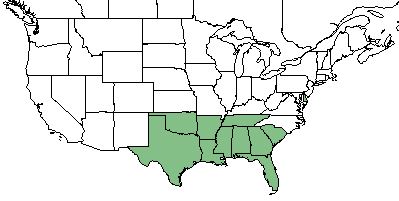Gratiola brevifolia
| Gratiola brevifolia | |
|---|---|
| Scientific classification | |
| Kingdom: | Plantae |
| Division: | Magnoliophyta - Flowering plants |
| Class: | Magnoliopsida - Dicots |
| Order: | Scrophulariales |
| Family: | Scrophulariaceae |
| Genus: | Gratiola |
| Species: | G. brevifolia |
| Binomial name | |
| Gratiola brevifolia Raf. | |

| |
| Natural range of Gratiola brevifolia from USDA NRCS Plants Database. | |
Common Name: sticky hedgehyssop[1]
Contents
Taxonomic Notes
Synonyms: none.[2]
Varieties: none.[2]
Description
Gratiola brevifolia is a dioecious annual or perennial that is a member of the Scrophulariaceae family, and grows as a forb/herb.[1] It grows erect and leafy.[3]
Distribution
This species occurs from South Carolina, southward to central peninsular Florida, westward to eastern Texas, and inland to southeastern Oklahoma, central Arkansas, and Tennessee. It also is reported to occur disjunct in Delaware.[1][4] Throughout most of its range, it is considered rare or imperiled by some,[4] but just uncommon by others.[3] While it was thought to be located in South Carolina, these populations were found to be misidentifications.[5]
Ecology
Habitat
G. brevifolia is found in sandy pinelands, oak barrens, sandy riverbanks,[4] floodplain forests, cypress swamps, and other wet places.[5] This species has been observed in a range of habitats including road ditches, a small marshy area, hydric hammocks, bottomland woodlands, swamp borders, swampy woodlands, moist meadows, longleaf pine-wiregrass communities, a boggy draw, and other similar wet areas. Soils include moist and acidic sandy soil, sandy loam, mucky soil, mud, sandy peat, and shaded loam.[6] This species is considered rare, and is generally associated with the longleaf pine ecosystem.[7] In the lower banks and bottoms of a ditched perennial stream, G. brevifolia consists of 1,500 individuals.[4] It is listed by the USDA Natural Resources Conservation Service as a facultative wetland species, where it is most often found in wetland habitats but can also occasionally occur in non-wetland habitats as well.[1]
Associated species include Dyschoriste humistrata, Justicia angusta, Saururus cernuus, Proserpinaca palustris, Sclerolepis uniflora, Amsonia rigida, Hibiscus moscheutos, Dichanthelium acuminatum var. wrightianum, Lechea sp., Aristida sp., Rhynchospora sp., Gratiola sp., and Xyris sp.[6]
Phenology
In the Florida panhandle, G. brevifolia flowers from March through July, with peak inflorescence in May.[8] It has also been observed flowering in September and October, and fruiting April through October but not in July.[6]
Fire ecology
It has been observed to grow in areas that are frequently burned.[6]
Conservation, cultivation, and restoration
Gratiola brevifolia has a global status of G4 due to its restricted distribution. It is also considered vulnerable in Arkansas and Georgia, and critically imperiled in Tennessee and Delaware.[9]
Cultural use
Photo Gallery
References and notes
- ↑ 1.0 1.1 1.2 1.3 USDA NRCS (2016) The PLANTS Database (http://plants.usda.gov, 02 February 2018). National Plant Data Team, Greensboro, NC 27401-4901 USA.
- ↑ 2.0 2.1 Weakley, A.S. 2015. Flora of the southern and mid-atlantic states. Working Draft of 21 May 2015. University of North Carolina at Chapel Hill, Chapel Hill, North Carolina.
- ↑ 3.0 3.1 Walker J (1993) Rare vascular plant taxa associated with the longleaf pine ecosystems: Patterns in taxonomy and ecology. Proceedings of the Tall Timbers Fire Ecology Conference. Tall Timbers Research Station, Tallahassee, FL.
- ↑ 4.0 4.1 4.2 4.3 Knapp WM, Estes D (2006) Gratiola brevifolia (Plantaginaceae) new to the flora of delaware, the delmarva peninsula, and the mid-Atlantic. SIDA 22(1):825-829.
- ↑ 5.0 5.1 Weakley AS (2015) Flora of the Southern and Mid-Atlantic States. Chapel Hill, NC: University of North Carolina Herbarium.
- ↑ 6.0 6.1 6.2 6.3 Florida State University Robert K. Godfrey Herbarium database. URL: http://herbarium.bio.fsu.edu. Last accessed: May 2019. Collectors: Loran C. Anderson, Wilson Baker, K. Craddock Burks, Bob Fewster, Robert K. Godfrey, C. Jackson, J. M. Kane, Brian R. Keener, Robert Kral, Marc Minno, Robert A. Norris, William Platt, Jesse M. Shaver, Cecil R. Slaughter, H. K. Svenson, John W. Thieret, and Alfred Traverse. States and Counties: Alabama: Pike and Washington. Florida: Flagler, Franlin, Gadsden, Jefferson, Leon, and Wakulla. Georgia: Brooks, Sumter, and Thomas. Louisiana: Beauregard. Tennessee: Coffee and Grundy. Texas: Harris and Van Zandt.
- ↑ Walker, J. (1993). Rare vascular plant taxa associated with the longleaf pine ecosystems: Patterns in taxonomy and ecology. Tall Timbers Fire Ecology Conference, Tall Timbers Research Station, Tallahassee, FL.
- ↑ Nelson, G. PanFlora: Plant data for the eastern United States with emphasis on the Southeastern Coastal Plains, Florida, and the Florida Panhandle. www.gilnelson.com/PanFlora/ Accessed: 2 FEB 2018
- ↑ [[1]] NatureServe Explorer. Accessed: May 17, 2019